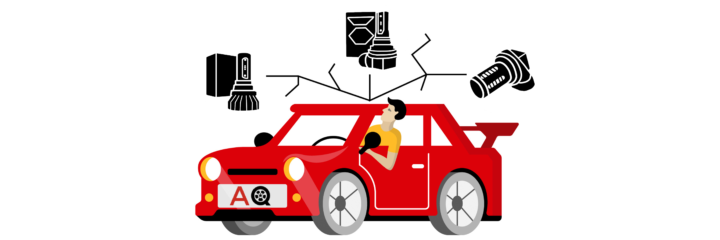While car owners sometimes refer to their brights as ‘fog lights,’ true fog lights are really a completely different category of headlights, installed separately from primary lights, daytime running lights, and brights. Unlike these conventional lights, which are all used during the daytime, fog lights are used to help other drivers see you in foggy and snowy conditions, while illuminating the road instead of reflecting off of the fog.
- What’s the Difference Between Fog Lights and High Beams?
- Features to Consider in a Car Fog Light
- Top 10 Best Car Fog Lights 2026
- 1. Best Overall Car Fog Light: Marsauto 9006 LED Headlight Bulbs
- 2. Best Budget Fog Lights: Sealight LED Fog Lights
- 3. Alla Lighting H11 LED Fog Light Bulbs
- 4. Best HID Fog Lights: HID Warehouse Xenon Replacement Bulbs
- 5. Alla Lighting Xtreme Super Bright
- 6. Best Premium Fog Lights: Hikari Ultra Fog Light Conversion Kit
- 7. Torchbeam T2 LED 12,000 Lumen Bulb
- 8. SNGL H16 Type 2 Super Bright CREE LED Fog Light Bulbs
- 9. Best for Ultra-Foggy Conditions: Alla Lighting H10 Fog Light Bulbs
- 10. Sylvania H11 SilverStar zXe Gold
- Guide to Buying the Best Car Fog Lights for 2026
- Frequently Asked Questions on Car Fog Lights
- Wrapping Up
What’s the Difference Between Fog Lights and High Beams?
When shopping for auxiliary lights, it’s important to know exactly what you’re looking for. While many use the terms ‘fog lights’ and ‘brights’ interchangeably, they’re quite different. As opposed to defining every type of auxiliary light, we’ll define fog lights below:
Fog lights are a specific type of headlight mounted on the car specifically to cut through fog and illuminate the road ahead. Instead of lighting up the whole field of vision ahead, as with a standard headlight, the lights have a cutoff meant to keep the road illuminated without illuminating the fog itself. Most commonly, they plug into an existing slot (typically a factory option) on your vehicle below your headlights on the bumper.
Features to Consider in a Car Fog Light
Since car fog lights vary from small accessories to huge light bar setups, features can widely vary between models. Considering the following features below can help you get to the perfect car fog light setup for your vehicle.
Type of Bulb
Although most fog lights in the past used to be powered by halogen bulbs, since LEDs and HIDs have become more widespread and affordable, popular car fog lights are now sold with all types of bulbs.
LED Lights
LEDs, short for light-emitting diodes, are an ultra-energy-efficient and inexpensive way to provide high levels of illumination. Although there are plenty of expensive LED setups, the least expensive fog lights also tend to be LED-based. Since they’re so efficient, they don’t tax car batteries as much as other types of lights.
Halogen Lights
Incredibly powerful, halogen bulbs light up the road or trail with astonishing brightnesses of up to 12,000 lumens. These bulbs are not built for energy efficiency by any means, and although they’ve been largely phased out for residential use, halogen bulbs still remain on the market for cars due to their incredible illumination abilities.
HID Lights
Hid lights, short for high-intensity discharge lamps, are bulbs that look like a thin version of the incandescent bulbs you’re familiar with in your home. They’re less common, but relatively efficient, and above average in brightness. They work fantastically when paired with a type of headlight glass called a projector lens.
Brightness
Each fog light on the market has a different brightness level. Fog lights will start out at about 500 lumens and can get up to well over 5,000 lumens, although brightness and lumenage doesn’t tell the whole story. Bright bulbs that don’t have a well-defined light pattern can spill over, lighting up the fog in front of you more than the road ahead.
Light Format
Car fog lights can be set up in different ways depending on the intended purpose. Some small-format lights are simply for temporary emergency use while large light bars are used for heavy-duty illumination.
Bulb
Headlight standards like H8, H9, and H11 are typically relatively compatible with one another and use only a single bulb to screw into an already-existing housing. These bulbs aren’t the brightest or most advanced fog lights, but they do represent a major advantage over the stock bulbs that come with your car.
Light Matrix
While these aren’t officially car fog lights, we’ll include them in our article as they are an incredibly useful type of auxiliary light that many consider when looking to add to their existing headlights. A light matrix is what it sounds like: a large grid of small, bright bulbs (typically LEDs) that illuminate the road. While these aren’t fog lights in the traditional sense (technically, fog lights are only the lights that screw into specific slots below the bumper), they can function as fog lights when mounted downwards illuminate the road.
| Product | Type of Bulb | Lumens | Mounting Standard | Rating |
|---|---|---|---|---|
| Marsauto 9006 LED Headlight Bulbs | LED | 4,000 | 9006, HB4, HB4U, 9006XS | 5 |
| Sealight LED Fog Lights | LED | 4,800 | H8, H9, H11, H16 | 4.5 |
| Alla Lighting H11 LED Fog Light Bulbs | LED | 2,800 | H11 | 4.5 |
| HID Warehouse Xenon Replacement Bulbs | HID | 2700 lm | H8, H9, H11 | 4.5 |
| Alla Lighting Xtreme Super Bright | LED | 5,200 | H8, H11 | 4.5 |
| Hikari Ultra Fog Light Conversion Kit | LED | 12,000 | H8 / H9 / H11 | 4.5 |
| Torchbeam T2 LED 12,000 Lumen Bulb | LED | 12,000 | H8, H9, H11 | 4 |
| SNGL H16 Type 2 Super Bright CREE LED Fog Light Bulbs | LED | 10,000 | H16 | 4 |
| Alla Lighting H10 Fog Light Bulbs | LED | 2800 | H10 | 4 |
| Sylvania H11 SilverStar zXe Gold | Halogen | 5,600 | H11 | 3.5 |
Top 10 Best Car Fog Lights 2026
1. Best Overall Car Fog Light: Marsauto 9006 LED Headlight Bulbs

Editor’s Rating:
At a Glance
- Type of Bulb: LED
- Lumens: 4,000
- Mounting Standard: 9006, HB4, HB4U, 9006XS
Fog light bulbs are notorious for being difficult to install: fingers don’t fit into the holes where they’re supposed to, the metal slots are fragile and easy to strip, and the threads are razor-sharp, making it easy to cut your hands open. This bulb is one of the easiest to install, with the heat sinks in a good spot to grip onto. They’re also ‘no polarity’ bulbs that will be ready to go after 5-10 minutes, as opposed to competitor bulbs that can require housing and cover modification or even wiring changes to get them to work properly.
These bulbs represent an improvement over a traditional halogen bulb of over 200%, but the brightness difference isn’t necessarily what helps with driver visibility: what most users consider to be more important is the tight spread of the bulb, which is really a beam of light more than an illuminating lamp. This is thanks not only to the pattern of the LEDs, but to the heat sink which helps direct the light and prevents the edges from diffusing outwards. Our only issue is lumenage, as you might prefer a slightly brighter bulb.
Pros
- No-polarity bulbs are easy to install
- Represent a 200% improvement over halogen bulbs
- Heat sink prevents bulb from diffusing light
Cons
- Slightly dimmer than other similar competitors
2. Best Budget Fog Lights: Sealight LED Fog Lights
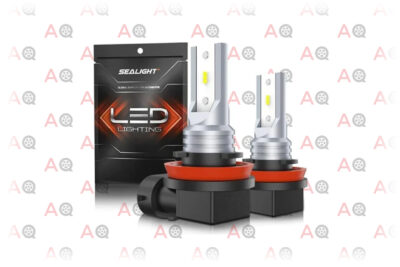
Editor’s Rating:
At a Glance
- Type of Bulb: LED
- Lumens: 4,800
- Mounting Standard: H8, H9, H11, H16
We’re impressed with these fog lights, a set of budget bulbs that come in at only about $20 per set. While inexpensive, they’re still impressively featured in terms of stats. 4,800 lumens is double that of other economical bulbs, a 6,000°-kelvin tint produces a colorless, sharp, white light, and their LEDs are made with proprietary 6CPS technology, producing crisp light that doesn’t diffuse over longer distances.
The particular bulb works in a wide variety of mounting standards, compatible with H8, H9, H11, and H16 fittings. This makes them quite a bit more versatile than other fittings. Be aware that the H16 fitting will produce a gentler, blue light, so if you’re looking for something ultra-bright and have an H16 fitting, consider a different bulb.
Pros
- Works with H8, H9, H11, and H16 fittings
- 4800-lumen brightness is double the brightness of other low-priced bulbs
- 6CPS tech produces bright light that doesn’t diffuse
- 6000 Kelvin tint is crisp and white
Cons
- When used with H16 produces blue light
- 4,800-lumen bulbs are less bright than expensive models
3. Alla Lighting H11 LED Fog Light Bulbs
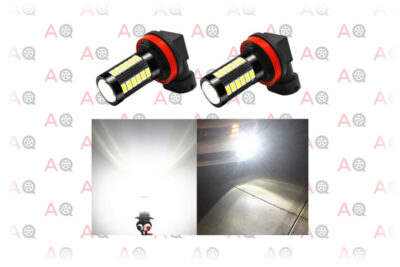
Editor’s Rating:
At a Glance
- Type of Bulb: LED
- Lumens: 2,800
- Mounting Standard: H11
These bulbs aren’t the brightest on our list at 2,800 lumens, but they have a whole host of extra features that make them a standout product in our book. The first is a year-long warranty, almost unheard of in products at this price point. The second is an ‘intelligent’ LED-integrated circuit which improves cooling of the LED lights, increasing performance, lifespan, and even durability (when hot, LED bulbs become more fragile).
Fitting into the H11 mounting standard and with a 6,000° Kelvin, ultra-bright white temperature, these are beyond the ‘pure white’ standard of 5,000° Kelvin into ‘blue light’ territory. While most drivers prefer yellow for extremely foggy conditions, plenty of drivers prefer the sharp, blue light these bulbs provide, especially in light fog or rain conditions.
Pros
- Use a lighter bulb with an intelligent circuit for durability
- Sharp blue light works in light fog or rain conditions
- Year-long warranty covers any damage or product failures
Cons
- 2,800-lumen bulbs are some of the dimmest on our list
- These bulbs don’t produce clear white light
4. Best HID Fog Lights: HID Warehouse Xenon Replacement Bulbs
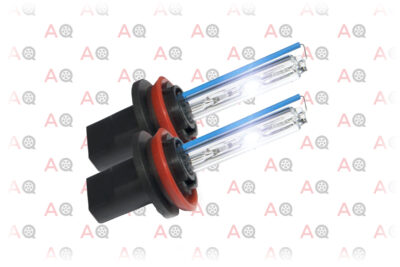
Editor’s Rating:
At a Glance
- Type of Bulb: HID
- Lumens: 2700 lm
- Mounting Standard: H8, H9, H11
HID lights make a comeback in this two-bulb set that’s compatible with H8, H9, and H11 sockets. While HID bulbs have shorter lifespans than LED bulbs, they have some distinct advantages over halogen lamps. From brightness to efficiency, HID lights have performance that’s orders of magnitude better than their halogen counterparts, for prices lower than LEDs.
While HID bulbs aren’t as bright as LEDs, they’re both accessible and cheap. High-end competitors like Hikari produce bulbs with prices approaching $100, these can be purchased in the $20 price range.
Product quality is backed up by a two-year warranty and a product guaranteed to stringent ISO 9001 standards for water and shock resistance. They’ve got many of the same quality assurances as LED bulbs for a fraction of the price. Due to their intricacies and low brightness, though, they’re best paired with a projector lens.
Pros
- Inexpensive bulbs far outcompete halogen competitors
- Great product quality with a strong year-long warranty
- Some of the cheapest bulbs on the market
- Holds up to stringent ISO 9001 standards for water and shock resistance
Cons
- Not as bright as LED bulbs
5. Alla Lighting Xtreme Super Bright
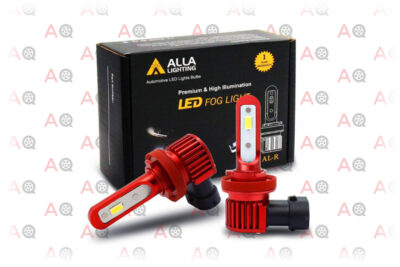
Editor’s Rating:
At a Glance
- Type of Bulb: LED
- Lumens: 5,200
- Mounting Standard: H8, H11
The main feature to pay attention to with these bulbs? 5,200, the number of lumens packed into each of these power LEDs. That’s about 600% more than your average stock bulb, yielding a noticeable improvement in both road surface illumination and visual range.
With a 6,000° Kelvin light temperature that gives an ultra-clear white light temperature, range is good, although this ultra-white light combined with 5,200 combined lumens of brightness in some cases actually worsens fog performance. As a set of backroad brights meant to illuminate the road or trail, these work fantastically, but in particularly foggy conditions, they light up the fog itself, making visibility even worse.
The bulbs use an H11 and H8 mounting standard, which fits most trucks in the United States. When considering these lights, make sure you check your vehicle’s owner’s manual to see if these bulbs will work for you. If they’re compatible, count on a full-year manufacturer’s warranty for any issues you have with the two-bulb set.
Pros
- 6,000° Kelvin bulbs produce clear white light
- 600% more illumination than a stock bulb
- 5,200 combined lumens of power (2,600 per bulb)
- Standard fitting that works with most trucks
Cons
- In extreme conditions they make visibility even worse

Editor’s Rating:
At a Glance
- Type of Bulb: LED
- Lumens: 12,000
- Mounting Standard: H8 / H9 / H11
If you’re looking for some ultra-high-end lights for your tuner car or JDM vehicle, this set from manufacturer Hikari could be what you’re looking for. They’re more heavily engineered than competitor products, with plenty of thought put into all aspects. From heat retention to light pattern and even the graphics on the lights themselves, there’s a reason these are the most expensive on our list by a factor of about two. The heat sink, counterintuitively, isn’t necessarily for overheating; LEDs run pretty cold anyways. Instead, it improves the focus, yielding to a more concentrated beam that projects light in a tight spread, great for fog, rain, and snow.
12,000 lumens at 6,000° Kelvin mean these are both brighter and have a cleaner white light pattern than comparable halogens. Independent testing shows that these bulbs put out light that’s 270% more bright than competitors. Part of that is thanks to the concentrated light pattern that makes these safer than competitor products to use in traffic. The attractive styling and beam-like spread makes these great for your car’s looks as well, although it comes at a high price.
Pros
- Compact lights are 270% brighter than stock competitors
- Heat sink keeps the pattern and spread cohesive
- Can be used in traffic safely
- Good for fog, rain, and snow
Cons
- Double the price of similar competitors
7. Torchbeam T2 LED 12,000 Lumen Bulb
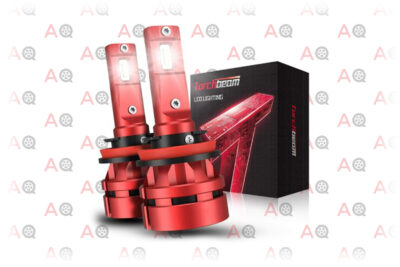
Editor’s Rating:
At a Glance
- Type of Bulb: LED
- Lumens: 12,000
- Mounting Standard: H8 / H9 / H11
At a practically-daylight 12,000 lumens with 6,500° Kelvin of crystal clear white light, it’s impressive that bulb manufacturer Torchbeam has managed to produce this level of light for a remarkably low price. This bulb, more than any other on our list, is designed to have impressive statistics: alongside the incredibly luminous, white bulbs is a 50,000-hour quoted lifespan. Considering that the average car’s lifetime is just a fraction of that, these might be the only set of bulbs you’ll buy for your car for as long as you own it.
Each of the two lights in this mid-range set utilizes just a single bulb, a relatively uncommon design for fog lights. While brightness is good in milder conditions, these bulbs have a tendency to diffuse in heavy fog, lighting up the mist just as much as the road ahead. This can be dangerous, although it’s probably not advisable to be driving in those conditions anyways. They’re almost too bright, although in low traffic conditions in milder weather, they’re perfect.
Pros
- H8 / H9 / H11 mounting standard is versatile
- 6,500° kelvins of light produce an incredibly clear, white light
- 50,000-hour quoted lifespan can outlast your car
- Can be used in low traffic conditions in mild weather
Cons
- Light diffuses in heavy fog, causing durability to suffer
- Can light up the mist instead of the road
8. SNGL H16 Type 2 Super Bright CREE LED Fog Light Bulbs

Editor’s Rating:
At a Glance
- Type of Bulb: LED
- Lumens: 10,000
- Mounting Standard: H16
These 6,000° Kelvin bulbs produce a clean white light via multiple light-emitting diodes on each stem, which doesn’t just improve light diffusion, but also means that you can lose a single LED without losing the entire light. While the manufacturer, SNGL, claims a powerful 10,000 lumens for these fog lights, that’s inaccurate on some level: the calculation is based on a sum total of each of the 12 LED bulbs in the product. Compare it to a single bulb design, and you end up with a brightness that’s realistically more in the range of 2,500 to 5,000 lumens.
They do have a unique feature that other fog lights in this price range don’t have: adjustability. Each bulb has a starting setting that can be doubled or tripled in brightness, maximizing utility on backroads or allowing you to tone down the light in case you want to use these lights on roads with heavier traffic.
Pros
- 12 bright LEDs pump out a sum total of 10,000 lumens
- Three adjustable levels of brightness
- Useful for drivers transitioning from high traffic to low traffic areas
- Improved light diffusion
Cons
- Brightness is overexaggerated due to measurement procedure
9. Best for Ultra-Foggy Conditions: Alla Lighting H10 Fog Light Bulbs

Editor’s Rating:
At a Glance
- Type of Bulb: LED
- Lumens: 2800
- Mounting Standard: H10
While these bulbs are impressively capable for being some of the cheapest H10 bulbs on the market, there are a few sacrifices that manufacturer Alla Lighting has made to cut down on the price. Firstly: lumens. 2,800 lumens (1,400 on each bulb) are better than a daytime running light, for sure, but actually less bright than most LED headlights on the market today.
That’s not the end of the world, however, as some diehards in ultra-foggy and ultra-snowy climates swear by lower lumen lights in the worst conditions. Still, though, if you’re expecting something ultra-bright, look for something with more lumens such as the SNGL H16 Type 2 Super Bright CREE LED Fog Light Bulbs.
They’re high-quality with a longer lifespan than most competitors, but don’t reach the 50,000-hour rating of expensive bulbs. They still back up their products, though. Alla Lighting is so confident in their bulbs that they’ll cover any material issues or product failures with their one-year warranty. It’s touches like that which make this already affordable product even more attractive, especially for shoppers on a budget.
Pros
- Economical bulbs are less bright but may be superior in poor-weather performance
- Cover product failures or material issues with a one-year warranty
- Lower lumen bulbs sometimes work better in lower conditions
Cons
- Those seeking brighter bulbs should look elsewhere
10. Sylvania H11 SilverStar zXe Gold
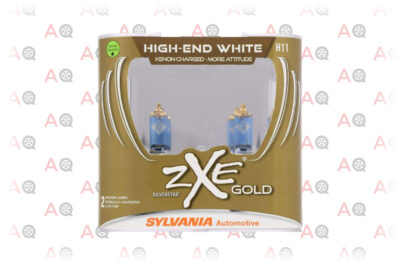
Editor’s Rating:
At a Glance
- Type of Bulb: Halogen
- Lumens: 5,600
- Mounting Standard: H11
While halogen bulbs have been largely replaced by LED fog lights, there are some drivers that are still fans enough to pay the product’s premium price. The soft, gently diffusing light is what many mountain residents prefer, especially when driving in the winter in heavy snowfall.
Unfortunately, there are reasons these lights have been phased out by automakers. Halogen bulbs begin to slowly dim after installation, with a working life of only 600-800 hours. This is just a fraction of many LEDs 50,000-hour quoted life expectancy (take the ultra-bright Torchbeam T2 LED 12,000 Lumen Bulbs) for example.
There’s another reason to buy the bulbs aside from nostalgia or personal preference, though: compatibility. Since halogen bulbs run at different wattages than LEDs, cars manufactured before the LED revolution will require a pair of halogen bulbs. This forces drivers to buy halogen bulbs, and represents a significant part of the halogen bulb market. Other fans of halogens quote personality, quality of light, and the fashion of having a retro-looking bulb.
Pros
- Halogen bulbs have stayed popular with many consumers
- Soft light is good for winter driving
- Some vehicles require halogen bulbs
- Some car fanatics prefer halogen bulbs for style purposes
Cons
- Halogen bulbs have been largely phased out in recent years
- 600 to 800-hour quoted life expectancy
- Begin dimming immediately after installation
Guide to Buying the Best Car Fog Lights for 2026
Fog lights are a product that you either need or don’t—and if you frequently drive in an area with inclement weather, well, you’ll need a pair. They’re not particularly expensive, either, as you can get a solid set of bulbs for around $20.
But not all cars take fog lights, and not all drivers need them. First of all, you need to have a port for fog bulbs: only cars with the proper fittings can accept fog lights. Secondly, you need inclement weather. If you’re not driving in fog, snowy, or rainy conditions, it’s not worth it to buy an expensive car fog bulb. If you’ve got the required features and you need to navigate difficult driving conditions, then it’s worth it to spend some money on an upgraded pair.
Should I Purchase Fog Lights as a Factory Option?
It’s next to impossible to purchase replacement, aftermarket fog lights unless you already have an existing spot to place them. This typically comes as a factory option, although some dedicated vehicle owners set up their own fog lights using a combination of aftermarket parts and some MacGyver-like ingenuity.
The decision to purchase factory fog lights is similar to the decision to purchase aftermarket ones. Examine your driving habits, the potential benefits, and the potential costs (these will be higher when selecting a factory option than with an aftermarket one). All things equal, they’re worth it, but when fog lights on high-end luxury vehicles can be a $1,000-plus option, the question gets a bit more complicated.
Mounting Standard
Different fog lights use different attachment methods to mount bulbs, meaning most cars will have different threads, different sized fittings, and different formats of bulbs. Those that are cross-compatible (H8, H9, and H11) all have different voltages, meaning they’ll all fit the same threading, but might have brightness variations based on the level of current.
H8 / H9 / H11
These bulb standards are generally compatible with each other save some exceptions. Check your owner’s manual to see exactly which standards your fog light slots are compatible with. Many manufacturers make lights that are universally compatible with these three standards, although you’ll want to double-check the wattage in most cases. If the wattage isn’t compatible with that of your car, you run the risk of burning out a bulb.
H10
H10 bulbs run at similar voltages to H8, H9, and H10 bulbs, although the threading is not cross-compatible. They’re often found in slightly older cars, although some manufacturers continue to use them today. They can sometimes be difficult to find in auto parts stores, meaning they’re a great candidate to be purchased online.
H16
H16 has the same standard fittings and threads as H11, although it operates at a different wattage. H16 bulbs produce a lighter blue hue due to the wattage they run at, which is considerably lower than that of traditional halogen bulbs.
HB
HB standards, sometimes labeled 9006 and 9006XS bulbs are less bright than competitors and produce a more diffused, softer light. They’re often preferred by those who frequently travel in inclement weather, especially in foggy conditions. While high-clarity, bright-white 6000° kelvin bulbs are great for snow and rain, they illuminate fog and sometimes make visibility even worse.
Other Standards
H8, H9, H10, H11, and H16 are easily the most common bulbs in American consumer cars, but occasionally rare, antique, or foreign cars might use another bulb standard. You’ll probably have to purchase these online as they’re not usually kept in stock at auto parts stores.
Cornering Fog Lights
The latest advancement in fog light technology is cornering fog lights, lights that rotate in their sockets in advance of cornering to illuminate the road ahead even before you begin turning. It’s really slick to see in action, and while in a perfect world, it marginally improves safety, manufacturers have had trouble with motor actuation and it often ends up being not only costly to install, but costly to fix as well.
Our advice? Stay far away if you can, and if you happen to have cornering fog lights on your car, make sure they get serviced at the dealer: often warranties can be voided or nullified when car owners decide to take repairs into their own hands.
Do I Need Car Fog Lights?
While the average urban driver might not need auxiliary lights, there are plenty of great reasons for a typical driver to buy some fog lights. Drivers who drive in the following conditions should think about a set of fog light bulbs.
Rural Driving
The countryside is sometimes downright pitch black and there’s a good reason a lot of rural dwellers need to replace their brights more than city slickers. Fog lights light up the road itself at distances of up to 200 meters, and they’re often positioned in a spot on the car that doesn’t harm the field of view of other drivers.
Off-Road Driving
Not only do off-road trails not have the great lighting so many urban drivers are accustomed to having well-lit roads, but their trajectories are typically narrow and curving as well. Off-road trails are obviously dark, less wide and driveable, and can have overhanging debris, rocks, and branches. A nice set of lights can keep off-roaders fully aware of the scenery both on and slightly off the trail.
Adverse-Weather Driving
In poor weather, an extra few feet of visibility can be the difference between getting in an accident and getting home safe. Even when not in life-or-death weather, having the best lights available to you can be worth it just for the peace of mind. Get home safe.
Tuners and Enthusiasts
Some nice lights go a long way with the automotive enthusiast community. Along with adding an additional spot to include some anodized metal, fog lights can provide some cool photo opportunities. A pro tip? Check out super high temperature (white and blue hues) bulbs for the coolest night time pics.
Car Fog Light Usage
As many cars, especially less expensive models, don’t have fog lights, it’s not always well known when and how fog lights should be used. After all, most drivers get away with just having standard lights, daytime running lights, and brights. So when should fog lights be used to maximize utility?
Fog lights have a different purpose than standard headlights (light up shared roads) and high beams (illuminate low-traffic roads when it’s very dark). With fog lights, there’s a simple rule: when your visibility is reduced to 100 meters due to weather conditions like snow, rain, or fog, or heavy darkness, use your fog lights.
Watch out for other drivers as fog lights can negatively affect other road users. You can be more liberal with fog light usage in low traffic areas: mountains, backcountry, and rural areas, for example. At the end of the day, though, use your own best judgement. You know what’s safest for you, so use your gut.
Are HID Lights Still Worth It?
Inexpensive and bright LEDs have saturated the market in recent years, now available in all bulb standards and representing most of the lights available. They continue to drop in price as manufacturing gets cheaper and distribution becomes ever more common, all that as they continue to get brighter and longer-lasting.
So if they’re bright, inexpensive, and long-lasting, how can ‘prehistoric’ lights stay competitive? Old bulb standards? Authenticity? Or is it preference that’s playing a role here? The answer: HID bulbs are really only competitive now against LEDs when paired with a specific type of headlight lens called a projector lens to help brighten and intensify the beam. Otherwise, no, they’re not usually worth it.
Colored Fog Lights
Different models of car fog lights sometimes use different color bulbs or tints to create colored light, performing better than white light under foggy conditions. The variation in this color is called light temperature and it’s measured in a unit called Kelvin. While standard fluorescent household bulbs are about 2,500 Kelvin, most car fog lights sit in the range between 3,000 and 6,000 Kelvin. This ‘warmer’ light is claimed by some to help pierce further in foggy conditions.
Frequently Asked Questions on Car Fog Lights
The important features of car fog lights, as with any aftermarket car part for enthusiasts, are sometimes obscured by marketing jargon and famous brand names. We clear up some of the most common questions below:
Will Fog Lights Fit on My Car?
Fog lights come in different form factors, from bulbs that fit into your existing headlight sockets to separately attached brackets that require some serious vehicle modification. So how do you tell if a specific fog light will fit on your car? You’ll have to check for yourself. In our descriptions, we’ve described attachment methods, most product descriptions will tell you which standards, housings, or brackets a specific light will use.
Are Car Fog Lights Legal?
While completely lighting up the road ahead of you makes for incredible safety advantages, bright lights shining in the path of oncoming traffic can have dangerous safety repercussions in the form of reducing visibility. So while off-road and rural drivers in adverse, wintry conditions can improve safety when driving, there are laws in place to prevent people from using fog lights when they could potentially harm other drivers.
While laws vary on a state-by-state basis, most states require fog lights to not be above a certain height, lighting up the road and not the fog itself. They also must be turned off in urban areas and when not necessary. For the most part, as long as you use fog lights with common sense and are aware of other road users, fog light use is totally legal.
How Do You Turn Fog Lights On?
Vehicles with slots or threading for fog lights will have a switch somewhere on the dashboard (it could be an independent switch, it could be on the same stalk as your brights and standard headlights). If you have wired your own fog lights, or if you plan to wire your own fog lights, you’ll probably have to come up with your own solution as auxiliary switches are difficult to adapt for aftermarket purposes.
What’s the Difference Between Fog Lights and Brights?
Fog lights and brights are often mistaken for each other when used in popular vocabulary, but they’re actually very different pieces of equipment. Brights come standard on every modern car, an additional setting for vehicles to use in low light conditions. But while they’re effective and increase the range and visibility of your vehicle, they’re a completely different animal than fog lights.
Fog lights are mounted below both headlights and brights, typically offered as an upgrade option when purchasing a car. They’re not available on all cars, and if they’re not installed as a factory option, it’s typically quite difficult to install them in the first place.
Wrapping Up
Fog lights, once you have a pair installed, are very easy to take for granted. But those who go from using their own auxiliary fog light system to a car without one can quickly realize how much they relied on the system in the first place! Fog lights will help you stay safe in dark, snowy, foggy, or rainy conditions, making sure you get home safe and sound every time.
